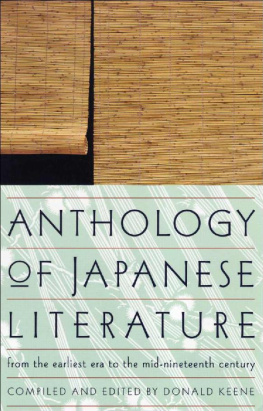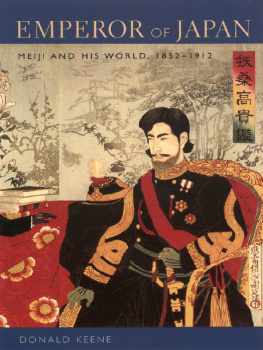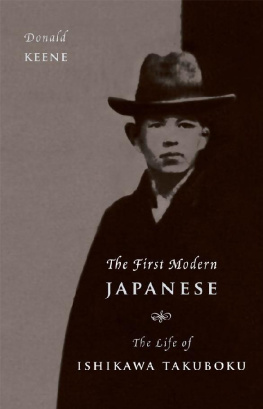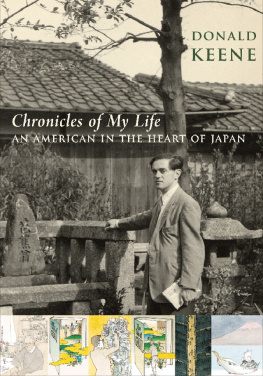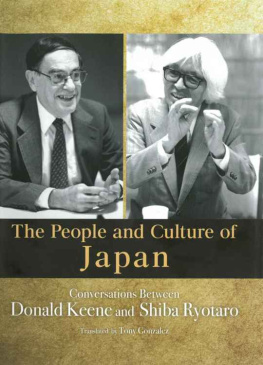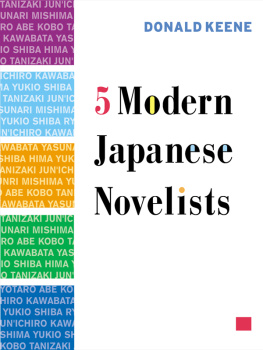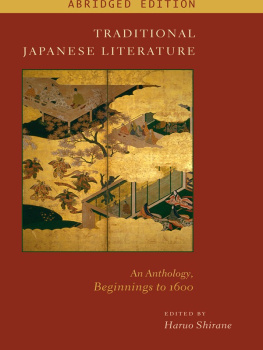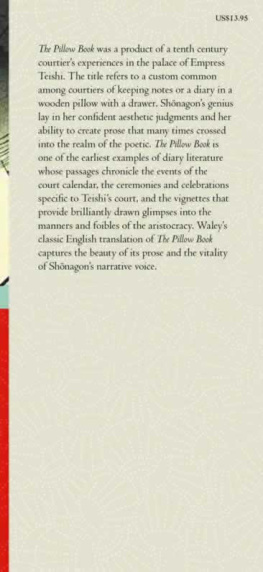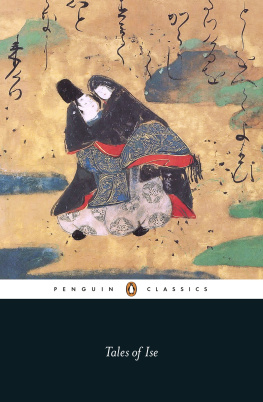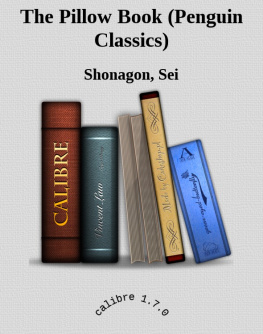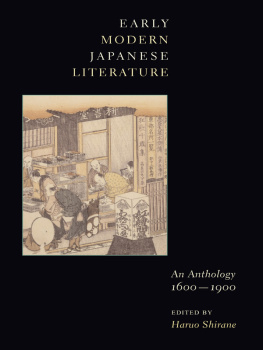ANTHOLOGY OF JAPANESE LITERATURE
WORKS BY DONALD KEENE
PUBLISHED BY GROVE
Anthology of Chinese Literature, Vol. I: From Early Times to the 14th Century (with Cyril Birch, ed.)
Anthology of Japanese Literature from the Earliest Era to the Mid-Nineteenth Century
Modern Japanese Literature: An Anthology
World Within Walls: Japanese Literature of the Pre-Modern Era (16001867)

Anthology of JAPANESE LITERATURE
from the earliest era to the mid-nineteenth century, compiled and edited by
Donald Keene

Copyright 1955 by Grove Press, Inc.
All rights reserved. No part of this book may be reproduced in any form or by any electronic or mechanical means, or the facilitation thereof, including information storage and retrieval systems, without permission in writing from the publisher, except by a reviewer, who may quote brief passages in a review. Any members of educational institutions wishing to photocopy part or all of the work for classroom use, or publishers who would like to obtain permission to include the work in an anthology, should send their inquiries to Grove/Atlantic, Inc., 841 Broadway, New York, NY 10003.
Published simultaneously in Canada
Printed in the United States of America
This volume is published in accordance with an arrangement between UNESCO (United Nations Educational, Scientific and Cultural Organization) and the Japanese Government.
Library of Congress Catalog Card Number: 55-5110
ISBN-10: 0-8021-5058-6
ISBN-13: 978-0-8021-5058-5
Grove Press
an imprint of Grove/Atlantic, Inc.
841 Broadway
New York, NY 10003
Distributed by Publishers Group West
www.groveatlantic.com
08 09 10 11 12 52 51 50 49 48
TO ARTHUR WALEY
NOTE ON JAPANESE NAMES AND PRONUNCIATION
Japanese names are given in this book in the Japanese order: that is, the surname precedes the personal name. Thus, in the name Matsuo Bash, Matsuo is the family name, Bash the personal name. However, Japanese usually refer to famous writers by their personal names rather than by their family names and this practice has been observed in the anthology.
The pronunciation of Japanese in transcription is very simple. The consonants are pronounced as in English (with g always hard), the vowels as in Italian. There are no silent letters. Thus, the name Ise is pronounced ee-say.
The Japanese words used in the text are those which have been taken into English and may be found in such works as the Concise Oxford Dictionary.
PREFACE
It can only be with diffidence that this first anthology of Japanese literature in English is offered to the reading public. I cannot recall ever having read a review of an anthology of European literature which did not point out glaring omissions and inexplicable inclusionsthis in spite of the comparatively long tradition of such anthologies. How much less likely it is, then, that the present volume will escape such criticism!
A word must therefore be said as to what principles guided the compilation of this book. It is, first of all, an anthology of Japanese works which translate into interesting and enjoyable English. No matter how important a work may be in the original, if it defies artistic translation I could not include it. Secondly, the selection is as representative of all periods of Japanese literature as is consonant with the above caveat. Thirdly, the anthology is as representative as possible of the different genres of Japanese literaturepoetry, novels, plays, diaries, etc.although, again, it must be borne in mind that in Japan, as in every other country, these various genres have not progressed uniformly. There is, for example, much great dramatic literature from the Muromachi Period but very little quotable poetry.
The length of a selection is not necessarily an indication of the relative importance of the work from which it is taken. It is easier to make extracts from certain types of writing than from others.
One rather unusual feature of the anthology is the inclusion of a limited number of works written by Japanese in the classical Chinese language. Just as Englishmen at one time wrote poetry and prose in Latin, so Japanese wrote in Chinese, with the difference, of course, that while they were writing there was still a country called China where the classical language was constantly being developed.
As I have noted, the translations in this book are meant to be literary and not literal. For example, names of persons, titles, and places not essential to a story have sometimes been omitted in the interest of easy reading for Westerners not able to absorb large quantities of Japanese proper names. Puns, allusions, repetitions, and incommunicable stylistic fripperies have also been discarded whenever possible. Extracts have been made with the intent always of presenting the given work in as favorable a light as possible, even though it might at times be fairer if the book were presented as rather uneven.
There are many objections to the practices cited above, and I am aware of them. But I think it highly important that this first anthology of Japanese literature have as wide an appeal as possible. For those interested in more literal versions of Japanese works, there are at least two scholarly books of recent years designed to meet their needs: Translations from Early Japanese Literature by E. O. Reischauer and J. K. Yamagiwa and The Love Suicide at Amijima by D. H. Shively. Both of these books give translations of complete texts; all allusions, wordplays, etc., are explained; and words which have been supplied by the translator are enclosed in brackets.
In presenting the anthology I have, for the sake of convenience, divided the literature into political periods: Ancient, Heian, Kamakura, Muromachi, and Tokugawa. However, this division is to be considered as little more than a convenience; it is obvious that a change of regime did not instantly produce a new literature, and it is sometimes indeed difficult to decide to which period a given work belongs. But, just as eighteenth-century literature has a meaning for us in spite of the qualifications we may make about its appropriateness as a general term, so Tokugawa literature makes enough sense for such a division to be made.
It will be noted that a majority of the translations in this book have never before been printed. Some of them have been made especially at my request, and at some urgency when the translators were engaged on other projects. I wish therefore to take this opportunity of thanking them all for their collaboration.
As far as my own translations are concerned, I should like to thank first Professor Noma Kshin of Kyoto University, under whom I have studied for two years; D. J. Enright and Carolyn Bullitt for help with the poetry; Hamada Keisuke and Matsuda Osamu for their useful suggestions on translations; and Edward Seidensticker for having read over my translations, pointing out the infelicities.
Acknowledgments are also due to: The Asiatic Society of Japan for the Kojiki and other works published in their Transactions; Professor Doi Kchi and The Kenkysha Publishing Company for The Diary of Lady Murasaki and The Sarashina Diary; Nippon Gakujutsu Shinkkai for the Manysh; Kenneth Rexroth for 100 Poems from the Japanese; A. L. Sadler for The Tale of the Heike; Dr. Sakanishi Shio for The Bird-Catcher of Hades and poetry by Ishikawa Takuboku and Yosano Akiko; G. B. Sansom for Essays in Idleness; Thomas Satchell for
Next page
